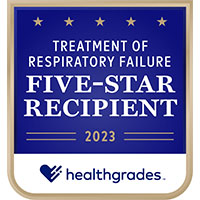Pulmonology
Helping Your Children Manage Their Asthma
What Is Asthma and What Are the Symptoms?
.jpg?sfvrsn=40409014_2) Asthma is a respiratory disease that affects the lungs and is the most common long-term disease in children. Symptoms of asthma include:
Asthma is a respiratory disease that affects the lungs and is the most common long-term disease in children. Symptoms of asthma include:
- Repeated episodes of wheezing
- Breathlessness
- Chest tightness
- Nighttime or early morning coughing
If your child has asthma, they’ll have it all the time but will have asthma attacks only when something bothers his or her lungs.
It’s not known what causes asthma and there is no cure, but it can be controlled if you:
- Know the warning signs of an attack.
- Stay away from things that trigger an attack.
- Follow the advice of your healthcare provider.
How Do You Know if Your Child Has Asthma?
Particularly in children under 5 years old, asthma can be hard to diagnose. Getting regular checkups that include checking your child’s lung function and checking for allergies can help.
If you suspect your child may have asthma, a lung function test can confirm he or she has the condition. The test measures the largest amount of air you can exhale after taking a very deep breath.
How Is Asthma Treated?
Doctors typically prescribe medicine to help treat your child’s asthma. There are a variety of methods that asthma medicines can be administered. They can be inhaled through the mouth or breathed in. Some can be taken as a pill.
There are two types of asthma medicines — quick-relief and long-term control. Quick-relief medicines control the symptoms of an asthma attack, while long-term medicines help your child have fewer and milder attacks. Long-term medicines, however, do not help during an asthma attack.
Things You Can Do to Reduce the Risk of an Asthma Attack
The following are a few things you can do to help reduce the risk of an asthma attack.
- Avoid outdoor air pollution — pay attention to air quality forecasts on radio and television and plan your activities for when air pollution levels will be low if air pollution aggravates your child’s asthma.
- Eliminate cockroaches – if you have any cockroaches in your home, take steps to get rid of them. Cockroaches and their droppings can trigger an asthma attack.
- Pets – furry pets can trigger asthma attacks. If you suspect your pet triggers attacks in your child and don’t want to find another home for the pet, bathe your pet weekly, keep it outside of your child’s bedroom, and vacuum often to clean up anything that could trigger an asthma attack.
- Mold – make sure your home is completely mold-free. Keep the humidity level in your home between 35% and 50%.
- Secondhand tobacco smoke – make sure your child doesn’t breathe any secondhand smoke and don’t let anyone else smoke around him or her.
- Dust mites – use mattress covers and pillowcase covers to create a barrier between dust mites and your child. Don’t use down-filled pillows, quilts or comforters. Remove any stuffed animals and clutter from your child’s bedroom.
By being informed and taking some precautionary steps, you can help control your child’s asthma and reduce the risk of asthma attacks.
Source:

 If you have pulmonary problems or suffer from a chronic lung disease, Saint Vincent Hospital can help you breathe easier. Designed to improve your quality of life, services include:
If you have pulmonary problems or suffer from a chronic lung disease, Saint Vincent Hospital can help you breathe easier. Designed to improve your quality of life, services include: